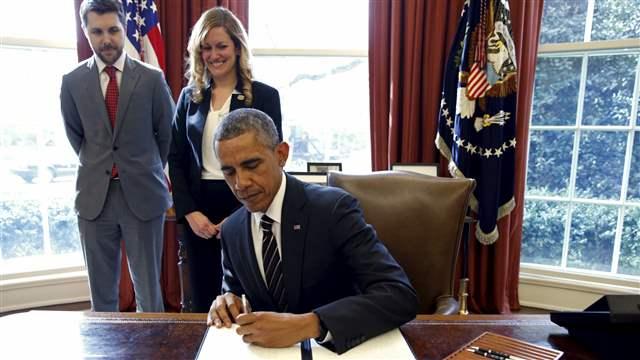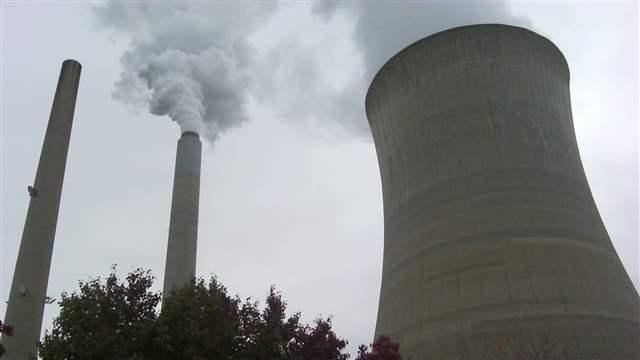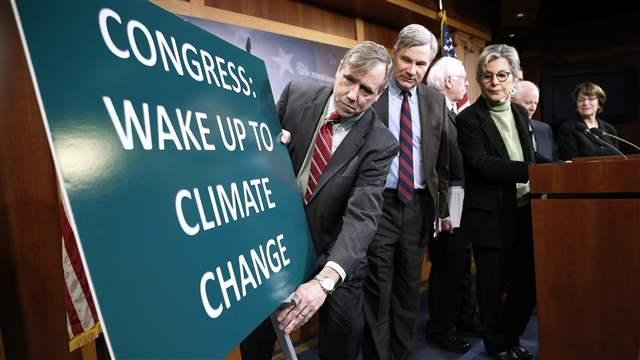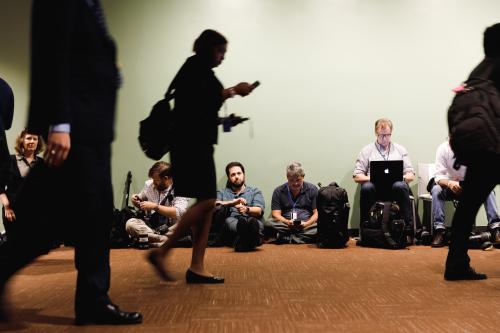A thoughtful analysis by several leading environmental law professors has shed new light on a long-dormant provision of the Clean Air Act (CAA). The provision is Section 115, titled “international air pollution.” The law professors strongly endorse it as a flexible, legally defensible tool with which to work toward our climate goals and suggest it could play a central role in the next round of policy initiatives to reduce U.S. greenhouse gas (GHG) emissions.
This assessment is on the mark. Section 115 has strengths that no other provision of existing law offers. Using it will not be easy. But failure to take advantage of its strengths will handicap U.S. policymakers in designing a path to achieve the ambitious GHG reduction targets that the Obama administration has pledged to meet by 2025.

A helicopter flies over the Hudson River with One World Trade Center and Lower Manhattan in the background, on a hazy day in New York City (REUTERS/Rickey Rogers).
How Section 115 Works
Section 115 enables the United States to work cooperatively with other nations to address transboundary air pollution. It imposes two conditions before the Environmental Protection Agency (EPA) can reduce domestic emissions affecting other countries: first, the EPA must have reason to believe that U.S. emissions cause or contribute to air pollution that will “endanger” public health or welfare in these countries; and second, the EPA must find that the endangered foreign country gives the U.S. “essentially the same rights with respect to the prevention or control of air pollution occurring in that country” as it enjoys under Section 115 itself.
If these conditions are met, the agency must give notice to the governors of the states where the emissions originate. The governors are then obligated to amend their State Implementation Plans (SIPs) under the act to the extent that they are “inadequate to prevent or eliminate” the pollution endangering the other country.
The first prerequisite for invoking Section 115 should present little difficulty. After the Supreme Court’s 2007 Massachusetts v. EPA decision affirmed the application of the CAA to GHG emissions from vehicles, the EPA determined that the contribution of these emissions to global climate change “endangered public health or welfare.” The D.C. Circuit Court of Appeals upheld the EPA finding, rejecting claims that U.S. vehicle emissions were too small to materially affect planetary warming, that the connection between climate change and GHGs lacked a sound scientific basis, and that the CAA framework for controlling vehicle pollution didn’t extend to GHGs.
With these issues resolved, the case for endangerment under Section 115 would be irrefutable since it would be based on U.S. emissions from all sectors, not just vehicles, and thus involve a greater impact on the global climate. And since Section 115 applies to “any pollutant . . . emitted in the United States,” the claim that GHGs are outside its scope would carry little weight as well.
The requirement of “reciprocity” under Section 115 may spark debate. Some may argue that there’s no real reciprocity unless the emission reduction commitments of the U.S. and the endangered countries are legally binding and enforceable under international law. But as the law professors convincingly argue, this would be a serious misreading of Section 115.
Failure to take advantage of its [Section 115] strengths will handicap U.S. policymakers in designing a path to achieve the ambitious GHG reduction targets that the Obama administration has pledged to meet by 2025.
The “rights” that Section 115 grants to foreign governments are limited and procedural in nature: they are merely entitled to participate in any public hearing on SIP revisions to reduce air pollution impacts on foreign nations. The United Nations Framework Convention on Climate Change (UNFCC) clearly confers equal if not greater “rights” on the U.S. to comment on and influence the GHG mitigation efforts of other countries. Indeed, it was through this give-and-take that the Individually Determined National Contributions (INDCs) that formed the basis for the COP-21 agreement were developed. And the COP-21 agreement itself creates additional opportunities for consultation among signatory nations, including the ability to comment on national targets and implementation plans, conduct technical reviews of these plans, seek written answers to questions, receive biennial progress reports, and weigh in on future national targets before and during subsequent COPs.
If Congress had wanted to allow the EPA to regulate U.S. sources of transboundary pollution only where the U.S. has entered into legally binding agreements with other emitting countries, it could easily have said so. But Section 115 instead sets a much lower bar, requiring only that other countries give the U.S. a seat at the table on emission policies that might affect U.S. health and welfare. The consultation opportunities created under the UNFCC framework should readily clear this bar.
A Flexible and Workable Framework for GHG Reduction
By selecting the SIP process as the vehicle for reducing pollution under Section 115, Congress provided the Agency with a flexible and practical set of tools. Because of its long history in supporting air quality planning and implementation, the process is well-understood and has a proven track record. It’s also designed to be applied on a multi-sectoral basis so it can include a range of GHG-emitting industries.
The CAA gives SIP planners a broad choice of pollution control measures, including market-based mechanisms such as fees, marketable permits, and auctions of emission rights. The EPA has used this authority successfully to establish multi-state cap-and-trade programs for emissions of nitrogen oxides (NOx) and sulfur dioxide (SO2). While the SIP process has historically been limited to pollutants contributing to violations of national air quality standards, the CAA allows it to be applied to other pollutants and the Supreme Court has upheld its use in controlling GHG emissions.
Bridging the Gap between Current Emissions and the COP-21 Targets
The Obama administration has used existing laws creatively and effectively to put U.S. emissions on a downward trajectory. But the GHG reduction programs now in place or on the drawing board will be insufficient to meet 2025 reduction targets and may even fall short of the more modest 2020 targets agreed to at the 2009 COP in Copenhagen. Thus, policymakers will need to turn to more powerful drivers in order to bend the emission curve more dramatically.

U.S. President Barack Obama signs an Executive Order, titled “Planning for Sustainability in the Next Decade,” which will cut the Federal Government’s greenhouse gas (GHG) emissions 40 percent over the next decade from 2008 levels, in the Oval Office of the White House in Washington (REUTERS/Kevin Lamarque).
According to the EPA’s most recent inventory, U.S. GHG emissions in 2014 were 9 percent below 2005 levels. Further declines can be expected as natural gas and renewables continue to replace coal in the power sector, vehicle fuel economy improves, methane emissions are better controlled, heavy-vehicle GHG emissions are regulated, and hydrofluorocarbon use in refrigeration is limited. But while the trend-lines are in the right direction, the exact magnitude of reductions we can expect is uncertain because we don’t know how quickly existing policy measures and advances in technology will decarbonize the economy.
Thus, the consultancy Rhodium found that, under optimistic assumptions, the 17 percent emission reduction that the U.S. committed to in Copenhagen in 2009 is “within reach.” But it also cautioned that, given the uncertainties, the most likely scenario is that U.S. emissions will decline by only 15 percent by 2020 and, under worst case conditions, they might merely be 10 percent below 2005 levels.
If the United States falls short of the 2020 target, the goal of a 26-28 percent reduction by 2025 will become that much more daunting. But even if ongoing and proposed policies meet expectations, there will be a substantial gap between the capabilities of programs now on the books and the scale of reductions necessary by 2025.
For example, Rhodium calculates that under an optimistic scenario where current programs deliver the high end of expected reductions, U.S. emissions will be 19 percent below 2005 levels in 2025, or 7-9 percent short of the 2025 target. It also examines more bullish and pessimistic scenarios under which the reduction shortfall might be bigger or smaller. Reflecting this range of projections, Rhodium pegs the size of the gap at 220-350 million metric tons (MMT) at the low end and 1,040-1,200 MMT at the high end. Although this is a large range, the gap is significant under all scenarios and demonstrates that, without a significant ramp-up of emission reductions, the 2025 goal will not be reached.
There will be a substantial gap between the capabilities of programs now on the books and the scale of reductions necessary by 2025.
Hitting the Ground Running
A new president committed to meeting the Paris targets will not have an extended window to study emission trends and policy options. Since new initiatives take time to formulate and often do not produce results for several years, an aggressive strategy to bend the U.S. emission curve significantly will need to be in place early in the next administration. Can existing legal authorities provide the tools necessary to construct and carry out this strategy successfully?
Here’s where Section 115 can play an important role.
According to the most recent EPA inventory, the U.S. GHG emission profile is dominated by electricity production (30 percent), transportation (26 percent), industry (21 percent), and commercial activities (7 percent). Meeting the COP-21 targets will require substantial emission cuts in all four sectors.
Recent progress in reducing overall U.S. emissions is largely due to rapid replacement of coal with natural gas and renewables in the power sector, which has outpaced the rest of the economy in reducing its carbon footprint. If upheld, the administration’s Clean Power Plan (CPP) will accelerate these trends. However, the COP-21 targets may not be achievable unless the power sector outperforms the final CPP 2030 goal (a 32 percent reduction from 2005 levels) and thereby compensates for smaller reductions in other sectors.
Transportation emissions, too, have come down due to improvements in fuel efficiency spurred by Obama administration vehicle efficiency standards. However, the level of reductions has been smaller than in the power sector. In addition, by encouraging a shift to larger vehicles and greater vehicle use, the drop in gasoline prices has resulted in a smaller decline in fleet-wide emissions than projected by the administration, even as automakers comply with efficiency requirements for individual models. The upcoming 2017-2018 review of the standards could offset this development by further tightening emission limits. However, it’s an open question how much more improvements in conventional engine technologies can reduce emissions and whether such improvements must be coupled with significantly greater penetration of electric vehicles or other non-emitting technologies in the marketplace.

The American Electric Power Company’s cooling tower at their Mountaineer plant is shown in New Haven, West Virginia (REUTERS/Ayesha Rascoe).
Progress has been smallest in the Industrial and commercial sectors, where emissions have remained at 2005 levels and actually increased modestly in recent years after an earlier decline. Rhodium projects further increases, with industrial emissions rising by another 18 percent by 2025 unless curtailed.
Section 115 offers obvious advantages in addressing emissions from industrial and commercial sources, which have largely been untouched by Obama administration policy initiatives. The EPA has based the CPP on its authority to issue new and existing source standards under CAA Section 111, but the CPP model of treating the electricity grid as a “system” is unlikely to work well for industrial sectors like cement, petroleum refining, chemical manufacturing, and iron and steel. These sectors have far fewer facilities than the power sector. Developing sector-by-sector performance standards under Section 111 would not only be time-consuming but would likely result in prescriptive requirements that offer limited opportunities for emission trading and other cost-effective measures. Section 115, by contrast, would authorize a multi-sector approach implemented through emission allowances and trading, which would preserve the operational flexibility of industrial facilities, allow compliance costs to be spread over a broader universe, and encourage low-cost reduction strategies.
Section 115 also provides opportunities to further reduce power sector emissions. Should the CPP be overturned in the courts, Section 115 would provide a fallback implementation mechanism. Even if the CPP is upheld, as many believe likely, recasting its requirements under Section 115 would open the door to emission trading between power plants and other sectors. This would not only be beneficial to industrial facilities but would create further incentives for reductions in power plant emissions. In addition, Section 115 would allow the use of “offsets” (such as credits from forest management programs) as a compliance option, a path that is not available under the CPP, which only credits emission reductions achieved within the power sector itself.
As the law professors point out, Section 115 also allows for integration of transportation fuels regulation with emission reduction strategies for the power, industrial, and commercial sectors. Building on the California example, this could take the form of distributing allowances to marketers based on the carbon content of their fuels, which would create incentives for reducing transportation emissions beyond those created by national fuel efficiency standards. Such a system might encompass electricity producers who distribute power to electric vehicle fleets, providing another opportunity to earn credits which are not available under the CPP.
Placing Responsibilities on the States
Since the SIP process is the mechanism for emission reductions under Section 115, implementation responsibility would rest with the states. Similar to the CPP, the EPA would likely conduct a national rulemaking to establish a framework of emission targets, deadlines and compliance mechanisms that states would need to convert into implementation plans. As under the CPP, the backstop of a federal implementation plan would be available if states fail to step up.
Section 115 will fare well in comparison to other approaches because it offers a legally defensible pathway, has the potential to achieve a magnitude of reductions that will bring the 2025 goals within reach, and will achieve reductions at lower cost and with greater flexibility.
Section 115 provides that SIPs must be revised so they are adequate to “prevent or eliminate the endangerment” posed by U.S. emissions to public health and welfare in foreign nations. This could be accomplished by setting a national emission reduction target commensurate with the 2025 U.S. goal under the COP-21 agreement. Since not all sectors would be subject to Section 115 SIPs and existing policy tools would be retained and perhaps expanded, this target would represent a portion of the total reductions necessary to achieve the U.S. goal; the balance would be contributed by other programs.
A national reduction target for Section 115 would then need to be apportioned among the states. One straightforward approach would be to calculate each state’s emissions from 115-regulated sources and then apply a uniform reduction percentage corresponding to the national target. However, as the CPP illustrates, any allocation of emission targets among the states can be a divisive exercise, and other approaches may be more equitable.
The ability to use market mechanisms under Section 115 will be a definite plus for states and industry, particularly in comparison with less flexible provisions of the CAA that might otherwise be employed. The SIP framework in Section 110 of the CAA, which is incorporated in Section 115, does not address how market-based programs should be designed. While the EPA’s success in establishing regional trading programs for NOx and SO2 under Section 110 is encouraging, translating that success into a GHG trading program under Section 115 will require careful thought. Questions about the auctioning of allowances, the role of offsets, the scope of interstate trading, and the use of emissions fees will be much debated, as under the CPP. An overriding issue will be how much uniformity in trading program design should be required. If the EPA sticks with the CPP model, states will have considerable latitude in constructing trading programs and a patchwork quilt of approaches may emerge. However, EPA might opt for a more homogenous trading framework that steers the states toward a national trading program or a few large regional programs.
States have long familiarity with using the SIP process to meet traditional air quality standards and the initial steps to develop state plans under the CPP have provided experience in using a similar process for GHG emission reduction. Still, use of Section 115 will be controversial. While states with strong climate policies will be supportive, states that have opposed the CPP may well have the same objections to a multi-sector emission reduction mandate under Section 115.
Weighing the Pros and Cons
Although there are downsides and political costs, a new president will have to weigh Section 115 against other available tools. Section 115 will fare well in this comparison because it offers a legally defensible pathway, has the potential to achieve a magnitude of reductions that will bring the 2025 goals within reach, and will achieve reductions at lower cost and with greater flexibility than other options. A more incremental approach may be a smaller target for critics but will carry the risk of falling significantly short of the 2025 goal and could have legal and political vulnerabilities in its own right.

U.S. Senator Jeff Merkley (D-OR) (L) adjusts a sign at the start of a news conference led by Senator Barbara Boxer (D-CA) (3rd R, at lectern) to draw attention to climate change at the U.S. Capitol in Washington (REUTERS/Jonathan Ernst).
Critics will say that Section 115 is a backdoor device to establish the very economy-wide cap-and-trade program that Congress failed to enact in 2009 when it shelved the Waxman-Markey climate legislation. That may be true. But the solution isn’t inaction by the executive branch but greater willingness by Congress to engage in a serious conversation on climate change. Many voices in industry are calling for a price on carbon and more members of Congress seem open to the prospect. But it’s far from certain that Congress will mobilize behind legislation. A new president should reach out to Congress but at the same time roll out a comprehensive emission reduction strategy using section 115 so that no time is lost in working toward the COP-21 targets.
Bob Sussman served in the Obama administration during 2009-2013 as co-chair of the Transition Team for the EPA and then as senior policy counsel to the EPA administrator. He was a senior fellow at the Center for American Progress in 2008, writing and speaking about climate change and energy. In 2007 he retired as a partner at Latham & Watkins. He previously served in the Clinton administration as the EPA deputy administrator. He is now on the adjunct faculty at Georgetown Law Center and Yale Law School and is a consultant on energy and environmental policy.
The Brookings Institution is committed to quality, independence, and impact.
We are supported by a diverse array of funders. In line with our values and policies, each Brookings publication represents the sole views of its author(s).



Commentary
The essential role of Section 115 of the Clean Air Act in meeting the COP-21 targets
April 29, 2016